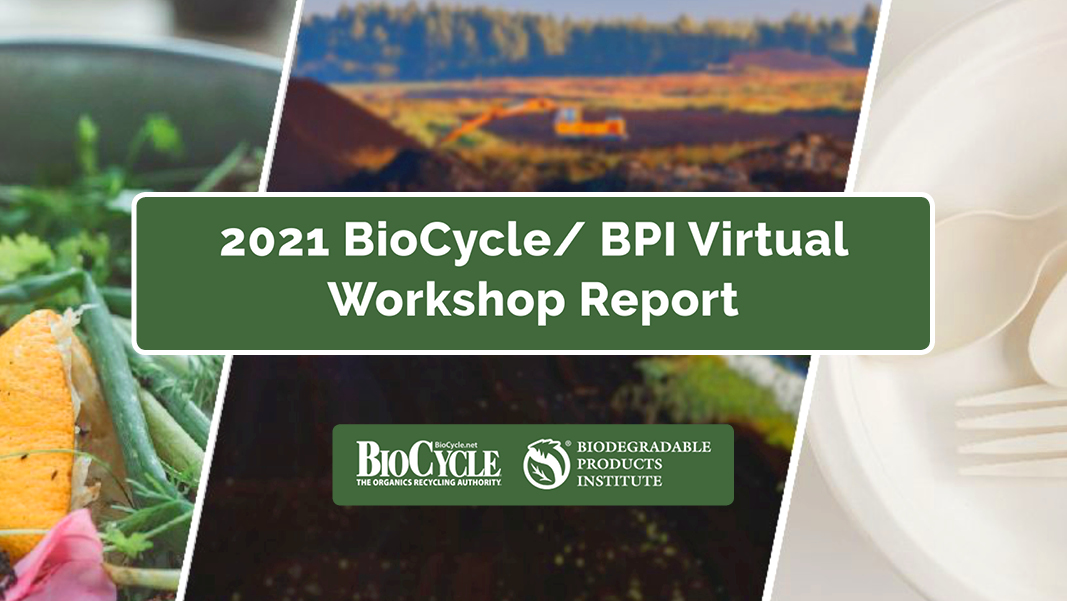Nora Goldstein
Last October, I was invited by the Biodegradable Products Institute (BPI) to facilitate a virtual workshop series to identify and confirm the top barriers to accepting and composting certified compostable packaging. The stated goal of the workshop series was to “build consensus on a single set of acceptability criteria so that compostable packaging can be accepted by a broader set of composters processing food scraps.” BPI recognized that the organics recycling and food and foodservice packaging industries had come to a fork in the road that could only be resolved by a willingness to work through the barriers related to compost manufacturer acceptance of food-contact, certified compostable packaging.
I had discussed that “fork in the road” in a February 2020 Editorial, “The 2020 Compostable Packaging Narrative,” where I called for a new narrative to address two underlying questions:
- Does the composting industry want to be part of the global effort on a food-contact packaging solution?
- Are producers and users of certified compostable food-contact packaging willing to support the composting industry on its path to being part of the solution?
The workshop series proposed by BPI presented me with an opportunity to participate in a consensus building process that would help create that new narrative. Participants would be drawn from four stakeholder groups: Composters and haulers, municipalities, operators (e.g., users of compostable products) and brands, and compostable product and material manufacturers. Ultimately, the stakeholders were comprised of 14 haulers and composters, 5 municipalities, 6 foodservice operators and brands, 15 compostable product and material manufacturers, 2 composting associations, and a subject matter expert. (Organics haulers are included with composters because some stakeholders provide one or both services.)
BioCycle worked with Wendell Simonson, BPI’s Marketing Director and Rhodes Yepsen, BPI’s Executive Director — along with a task force of BPI Board Members — on the workshop project. Today (March 17, 2021), BioCycle, in coordination with BPI, is releasing the 2021 BioCycle/BPI Virtual Workshop Report. This article highlights key steps of the process and the outcomes. The report includes detailed information on the entire process — which launched with questionnaires for the four main stakeholder groups, followed by 30-minute phone interviews, two 2-hour workshops that included stakeholders filling out ballots on proposed actions to resolve barriers, and a report out to participants where the final Roadmap and Action Plan were presented.
While the work described in the Roadmap and Action Plan represents the full range of the conversations had during the workshop sessions, it is by no means an exhaustive list of what will be required to get to the ultimate goal of increased organics diversion by way of a single set of acceptability criteria for compostable packaging. It is, however, a complete expression of the challenges and opportunities at this time. “We see this is a critical moment, where there is a broad push to both divert food scraps to composting, and to redesign non-recyclable food-contact items to be compostable,” says Yepsen. “It could be a watershed moment for moving towards zero waste and the circular economy, but we need alignment across all stakeholders to get there.”
Questionnaires About Barriers
The consensus-building process was anchored by the reality that there is tremendous market demand for compostable packaging, but composters are having varying degrees of success accepting and processing the material. The term “successful processing” shows up frequently in the language used for the workshop project. For example, some composters, for a variety of reasons, accept compostable products but screen them out before any processing ever takes place.
Notes BPI: “Compostable products and packaging exist to facilitate the diversion of food scraps from landfills, but the products and packaging themselves must also be diverted from landfills if the zero waste value proposition that attracts food service operators, brands, end users and consumers to them is to be realized. The treatment of key barriers in these workshop sessions, and for BPI more broadly, assumes that the screening out of compostable products before processing is not a viable solution in the long term, though it may be a practical one in the short term. It may also be the best indicator of how challenging these barriers have become for some composters, and will hopefully bring increased urgency to the work ahead.”
In addition to building consensus for a single set of acceptability criteria, the other stated goal of the workshop series was to “identify and confirm the top barriers to the acceptance and successful processing of certified compostable products.” The questionnaires for each major stakeholder group were designed to generate responses regarding the efficacy of compostable products in the effort to collect and process food scraps, and the most commonly cited barriers to the acceptance and successful processing of these products. (The questionnaires are in the Appendix to the Report.) Figure 1 show the haulers, composters and municipalities’ responses to several core questions and barriers:
- Do you think compostable products help you process more food scraps?
- How challenging is contamination from non-compostable products?
- How challenging is the issue of compostability standards as it relates to products meeting ASTM standards not breaking down fast enough?
- How challenging is the issue of organic agriculture standards limiting end market opportunities? (Compostable packaging is considered a synthetic that cannot be present in certified organic compost.)
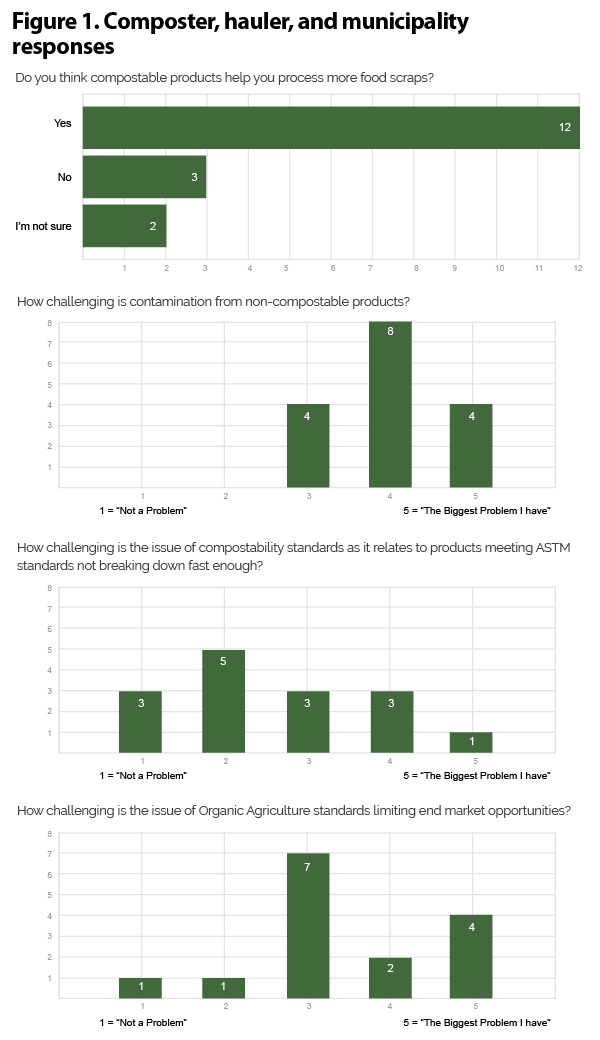 The survey results confirmed an operating assumption that BPI has had for some time — that the three most commonly cited barriers to the acceptance and successful processing of compostable products are: Contamination; Compostability Standards (products that meet ASTM standards not breaking down fast enough in “real world” environments); and Organic Agriculture Standards (limited end market opportunities for finished compost in which compostable products are an input). Given that there were only two, 2-hour workshop discussion sessions to work with, the decision was made to dedicate the first session to the Contamination barrier, and the second session to the Compostability Standards barrier. Because Organic Agriculture Standards are a policy barrier, the thought was it would benefit less from group discussion than the other two.
The survey results confirmed an operating assumption that BPI has had for some time — that the three most commonly cited barriers to the acceptance and successful processing of compostable products are: Contamination; Compostability Standards (products that meet ASTM standards not breaking down fast enough in “real world” environments); and Organic Agriculture Standards (limited end market opportunities for finished compost in which compostable products are an input). Given that there were only two, 2-hour workshop discussion sessions to work with, the decision was made to dedicate the first session to the Contamination barrier, and the second session to the Compostability Standards barrier. Because Organic Agriculture Standards are a policy barrier, the thought was it would benefit less from group discussion than the other two.
Future State Definitions And Action Items
As a guide for the discussions, future state definitions for Contamination and Compostability Standards were generated and circulated to the participants. These future state definitions captured BPI’s expressions of what success looks like on the contamination and compostability standards barriers, and relied heavily on the feedback participants gave in their survey responses and interviews:
- Contamination Future State: “Contamination from non-compostable products does not prevent composters from accepting and successfully processing compostable products.”
- Compostability Standards Future State: “Composters have enough information on “real world” performance to trust that products meeting ASTM standards will break down in facilities designed to accept food scraps and packaging.”
A list of proposed action items to bridge from the present state to the desired future state for each barrier was generated, again with heavy reliance on the survey responses and interviews. The action items were divided into different categories: Regulatory, Product Labeling, Field Validation of ASTM Standards, Awareness & Education, and Operational Support for Composters. The action items had specific elements to be included. Examples include:
- Regulatory Action to promote model bill language: Suggested elements — requires third-party certification for compostable products; requires specific labeling and identification methods for compostable products; and prohibits specific labeling and identification methods for non-compostable products.
- Product Labeling Action: Fund and execute research project for end user and consumer testing of on-product labeling techniques for compostable products; and update BPI’s 2020 labeling guidelines to reflect research and missing stakeholder input from Brands, Operators, Composters and Municipalities.
- Field Validation of ASTM Standards: Develop (or build on an existing) collaborative program designed to generate comprehensive data on the performance of certified products in composting facility systems.
- Awareness & Education: Drive standardized education efforts on the existing ASTM compostability standards, required testing, and what the results say about how a product will perform in “real world” environments.

 The proposed action items were the basis for small and large group discussions during each session, and all participants provided Yes/No expressions of support or non-support for each action item via electronic ballot at the end of the sessions. Participants also had the opportunity to write in proposed action items that were not included on the ballots, and to make general comments on topics related to the specific barrier being addressed. Ballot results and comments added to the ballots by the participants are captured in multiple figures in Section Two of the report. A sampling is provided in Figures 2-4.
The proposed action items were the basis for small and large group discussions during each session, and all participants provided Yes/No expressions of support or non-support for each action item via electronic ballot at the end of the sessions. Participants also had the opportunity to write in proposed action items that were not included on the ballots, and to make general comments on topics related to the specific barrier being addressed. Ballot results and comments added to the ballots by the participants are captured in multiple figures in Section Two of the report. A sampling is provided in Figures 2-4.
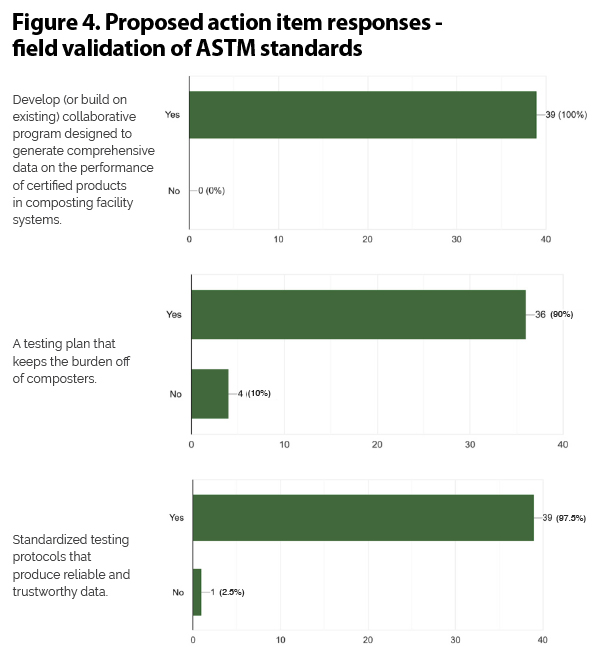 Roadmap And Action Plan
Roadmap And Action Plan
Based on the responses to the proposed action items, and all of the other comments and feedback received throughout the process, three new barriers and future states were generated to encompass the full range of projects identified as outputs of the workshop. Figure 5 — the Roadmap and Action Plan — presents the six barriers and future states debated, discussed and identified over the course of the workshop series. It also lays out BPI projects designed to resolve the barriers and reach the future states. Table 1 summarizes the six barriers and future states; Table 2 identifies the unique projects, scope of work, and timeline for each identified barrier.
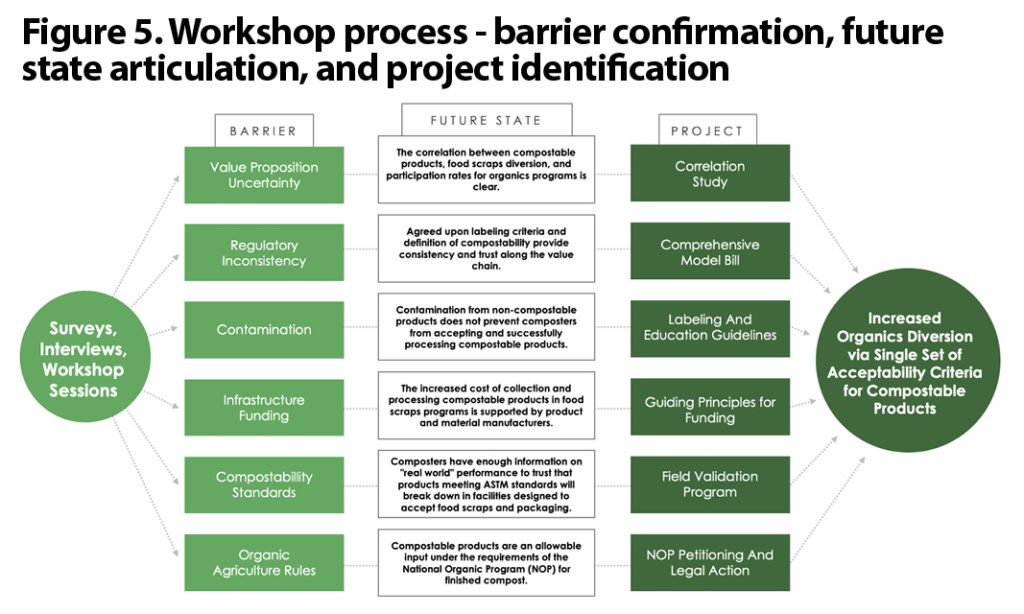 This Roadmap and stated actions reflects the consensus building that took place over the course of the BioCycle/BPI Workshop series. A somewhat traditional workshop process of convergence and divergence was used, whereby the participants started with a short list of underlying assumptions, which were then picked apart, examined, and expanded upon, before narrowing in on specific steps to achieve the ultimate goal: “Increased organics diversion via a single set of acceptability criteria for compostable products.”
This Roadmap and stated actions reflects the consensus building that took place over the course of the BioCycle/BPI Workshop series. A somewhat traditional workshop process of convergence and divergence was used, whereby the participants started with a short list of underlying assumptions, which were then picked apart, examined, and expanded upon, before narrowing in on specific steps to achieve the ultimate goal: “Increased organics diversion via a single set of acceptability criteria for compostable products.”
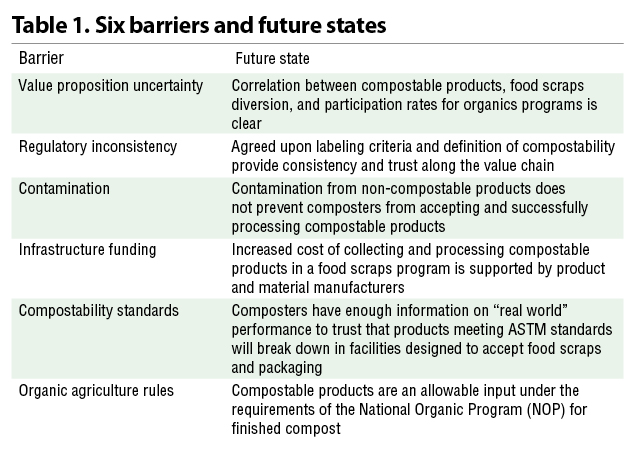
 “After the workshops, it was exciting to see all of our collective work come together and form six cohesive projects,” says Simonson. “When we showed the draft Roadmap and Action Plan to the workshop participants in the report-out session, it was clear that we had landed on a solid set of agreed upon next steps.”
“After the workshops, it was exciting to see all of our collective work come together and form six cohesive projects,” says Simonson. “When we showed the draft Roadmap and Action Plan to the workshop participants in the report-out session, it was clear that we had landed on a solid set of agreed upon next steps.”
At the end of 2019, BPI created a Stakeholder Membership to involve a wider range of voices, and made membership complimentary for compost manufacturers and municipalities. A Composter and Municipality Committee has been formed, chaired by a composter on BPI’s Board of Directors, to provide input and oversight on projects coming out of this workshop series. “BPI will also be looking to external partners that share this vision of success and are willing to make the Future States a reality,” adds Yepsen.
BioCycle and BPI thank all of the participants for their time, energy, and honesty through the Workshop Series process.


